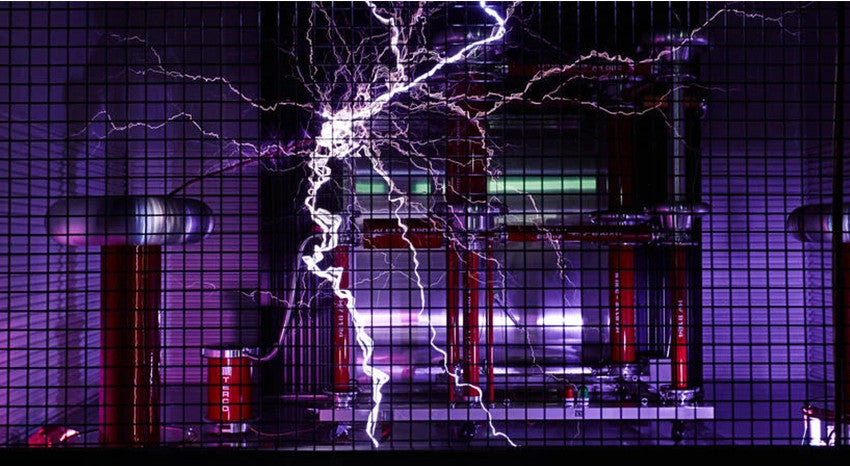What is Voltage?
What is Voltage?

Voltage is a term that we have all come across in daily life or in textbooks. You may know that AA batteries have a voltage of 1.5 volts (V), and smoke alarm batteries have a voltage of 9 volts (V). We also know that mains electricity, or household electricity, all are 110-120 volts (in the USA) while the voltage carried by large transmission lines is about 110 to 765 kilovolts (KV). From this, we can make a conclusion that low voltages such as those produced by batteries are harmless while high voltages can be dangerous. But what is voltage and What does it have to do with circuits?
What is Voltage? Voltage Definition, Potential Difference, and More
In short, voltage can be thought of as a force that pulls electricity (current) around a circuit. If a high voltage is applied to a circuit, then it will experience a high flow of electricity (i.e. current flow). If a lower voltage is applied to a circuit, then it will experience a lower flow of electricity. There is a good analogy for voltage that is water pressure. Holding a water tank high off the ground will cause the water to shoot out of the bottom faster than the tank was closer to the ground.

While this analogy of a water tank is great for learning the basics of voltage, however, it does not cover everything. For instance, voltages can be positive or negative (i.e. the direction in which they pull charges). Additionally, there are two types of voltage depending on what is being described. One is Electromotive Force (EMF), and another is Potential Difference (PD).
When the voltage is generated, the resulting voltage produced is referred to as Electromotive Force (EMF). When the voltage is lost over a component, then the resulting voltage is referred to as a Potential Difference. The Potential Difference can be considered as the loss of the pushing force.
Voltage definition: The force that pulls electricity current around a circuit.
What is Potential Difference: Loss of the pushing force.
Additionally, we may know that the voltage is the standard unit of Electromotive Force (EMF) or Potential Difference. Voltage is the accumulation of static electric charge flowing in one direction, such as an excess or deficiency of electrons measured, which is always related to voltage. Voltage is generated in an electrochemical reaction, and caused by light falling on a special semiconductor chip. When an object moves in a magnetic field or is placed in a fluctuating magnetic field, a magnetic field will be generated.
The Potential Difference between two points creates an electric field. There is always a pole that is relatively positive,(with fewer electrons) and a pole that is relatively negative,(with more electrons). Compared with the neutral object, the positive pole does not necessarily have a shortage of electrons, and the negative pole might not actually have an excess of electrons with respect to neutral things. But, the charge between the two poles is always different. The positive pole always has fewer electrons than the negative pole.

History of Voltage
Voltage can be traced back to Alessandro Volta, who was responsible for creating the first battery, the voltaic pile. This battery is incredibly simple and people can be made it at home with a few supplies found around the home. This battery is built using alternative layers of copper coins, zinc, and paper soaked in salt water all stacked on top of each other. While this is not a powerful source of electricity, it is demonstrated that electricity could be made chemically and experiments on dead frogs showed that the nerves used electricity rather than some special biological electricity. The term voltage is not coined by Alessandro Volta but instead was named after his achievements in this field of science.
Voltage Specifics - Voltage Units
Voltage is measured in volts and it is symbolized as V. While we know that the voltage can be thought of as a force that pulls electric current charges. However, we still do not know what one volt is and how it is defined. The scientific definition of one volt is when one coulomb of charge does one joule of work, but when dealing with electronics, this is rarely revisited or even considered.
Voltage, like force, has a polarity, which means that it can push or pull on an electric current. Voltage, like a force, is also relative, and the size of a voltage actually depends on where you measure it. When a voltage is measured, we can take two points and measure the difference between those two points. So if we connect the negative probe to the negative terminal and the positive probe to the positive terminal, there is 1.5V between the terminals of a 1.5V battery. However, if we connect the negative probe to the positive terminal and the positive probe to the negative terminal, we will instead read -1.5V (Voltage = Joules ÷ Coulomb, 1 Volt = 1 Joule per coulomb).
How is Voltage generated?
Remember how we said earlier that voltage came in two types? This matters a lot when talking about generating Voltage because when creating electric power, we are actually creating EMF and not the Potential Difference. So, how do we create an EMF? There are several ways in which an EMF can be produced, including electrochemical, electromechanical, thermal, and solar.
Electrochemical methods are including batteries and rely on chemistry to generate a potential difference between two terminals. Some batteries are wet, using a liquid as an electrolyte to carry charges between the two terminals, while some other batteries are dry.
Electromechanical methods are those that use mechanical motion and magnetic fields to induce current into wires. This is the most common method for electricity generation and can be found in power stations, dynamos, and motors.
Thermal methods rely on dissimilar metals that produce a voltage across them when they are coming into contact, and are often referred to as thermocouples. Peltier devices are those that convert the temperature difference between two sides of a special semiconductor into electric energy, which is commonly found in deep space missions (such as Voyager 1, Voyage 2, and New Horizons).
Solar energy is mentioned in its own category as light is directly converted into electricity with the help of special semiconductor arrangements. This technology enables photovoltaic panels to work and is increasingly becoming more popular around the world as a safe source of power.

Types of Voltage
There are two types of voltage which are AC and DC voltage.
In direct current (DC), the voltage is always constant, and the electricity flows in a certain direction. In contrast, in alternating current (AC), the voltage periodically changes from positive to negative and from negative to positive, and the direction of the current also periodically changes accordingly.
A different analogy can be used to exemplify Alternating Current and Direct Current. To establish a current, the electrons need to keep an orderly movement. Let's assume that the electron is a big box that simply needs to be moved. if it is moving the big box to the right all the way (that is DC), or if they keep moving the box to the right and to the left, alternating positions (that is AC).
How Does Voltage Work With Other Voltages?
Voltage is incredibly simple and easy to operate and work with. Voltages in parallel stay the same, and voltages in series add up. A common occurrence in electronics is to get a larger voltage supply than what a single battery can provide. While a larger battery can be chosen, it is often easier to use two identical batteries in series whose voltages add together. But remember that voltages have a polarity meaning if a battery is reversed then instead of adding to the overall voltage will instead subtract from it.
When you are connecting batteries in parallel, you must be sure that these batteries are all at the same voltage. If two dissimilar voltage of batteries is hooked up in parallel, then the larger battery will attempt to push current into the other battery which can cause it to overheat and potentially catch on fire.

Common Examples of Safe Voltage Sources
Voltage sources can be found in so many different places, but just because they exist does not mean that you can go to use them. For example, lighting is a very powerful source of electricity, but building a lighting mast and connecting an Arduino to it that is probably going to end very badly. The main power supply is usually a used power source for projects, but it can also be unsafe to use especially if an isolating transformer is not used. Therefore, always select a safe source of power using the list below.
Small solar cells (not the rooftop ones)
USB
Conclusion
Voltage is a fundamental concept in electronics and it will probably be the one thing that you are concerned about the most when designing circuits. So, knowing more about voltage is very helpful in daily life.
































